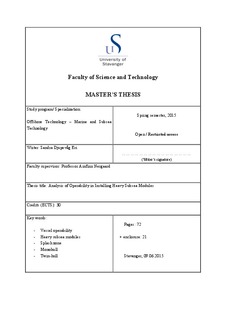| dc.contributor.author | Eri, Sandra Djupevåg | |
| dc.date.accessioned | 2015-09-14T13:20:53Z | |
| dc.date.available | 2015-09-14T13:20:53Z | |
| dc.date.issued | 2015-06-09 | |
| dc.identifier.uri | http://hdl.handle.net/11250/299749 | |
| dc.description | Master's thesis in Offshore technology : subsea technology | nb_NO |
| dc.description.abstract | Today (2015) subsea technology is a big part of the oil and gas industry. New subsea solutions are developed rapidly and large components that previously were placed on a platform are now being moved subsea towards the vision of a complete subsea processing facility. In order to ensure high operability of the subsea systems, it is essential to be able to perform marine lifting operations of subsea structures all year. This implies that high operability and large lifting capacity of the vessels are necessary.
This report deals with how the weight of subsea modules affects the vessel operability during installation operations. Subsea installation operations, from a typical 145 meter long construction vessel, have been analyzed, and limiting operational seastates for installation of three heavy subsea modules are defined. To evaluate the vessel’s ability to install the subsea modules, the marine dynamics program OrcaFlex has been used. The analysis is based on lifting the modules through the splash zone. Estimation of vessel operability and probability of experiencing a sufficiently long weather window for the operation period are conducted. Furthermore, a qualitative comparison study of monohull and twin-hull vessels has been performed to get an indication of whether they can compete on the same market.
The operability of the vessel has been calculated for installation of a module weighing 289 tons, 400 tons and 600 tons. Results from the feasibility study revealed that installation of the two lightest modules could be achieved in high seastates with high operability in North Sea environment. For installation of the heaviest module, the limiting seastate was reduced significantly, with a lower operability as consequence.
The qualitative comparison study revealed that the seastate is the limiting factor when performing subsea installation operations, and that the vessel motions are of less significance. Although a semi-submersible has favorable motion characteristics, it will not obtain a higher operability than a comparable monohull vessel. Furthermore, semi-submersibles generally have a higher lightship weight and they have a more complex structure compared to monohulls, which results in a higher cost of lightship weight per unit from the shipyard. | nb_NO |
| dc.language.iso | eng | nb_NO |
| dc.publisher | University of Stavanger, Norway | nb_NO |
| dc.relation.ispartofseries | Masteroppgave/UIS-TN-IKM/2015; | |
| dc.rights | Navngivelse 3.0 Norge | * |
| dc.rights.uri | http://creativecommons.org/licenses/by/3.0/no/ | * |
| dc.subject | offshore technology | nb_NO |
| dc.subject | vessel operability | nb_NO |
| dc.subject | heavy subsea modules | nb_NO |
| dc.subject | splash zone | nb_NO |
| dc.subject | monohull | nb_NO |
| dc.subject | twin-hull | nb_NO |
| dc.subject | subsea | nb_NO |
| dc.subject | undervannsteknologi | nb_NO |
| dc.title | Analysis of operability in installing heavy subsea modules | nb_NO |
| dc.type | Master thesis | nb_NO |
| dc.subject.nsi | VDP::Technology: 500::Marine technology: 580::Offshore technology: 581 | nb_NO |

